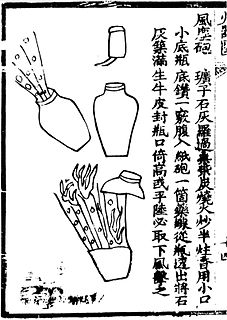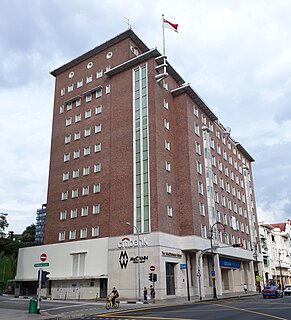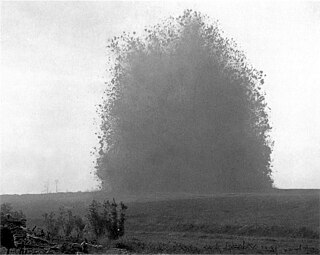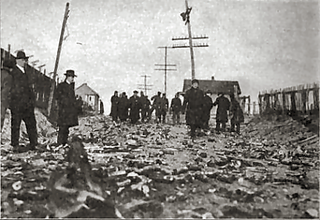
Shrapnel shells were anti-personnel artillery munitions which carried many individual bullets close to a target area and then ejected them to allow them to continue along the shell's trajectory and strike targets individually. They relied almost entirely on the shell's velocity for their lethality. The munition has been obsolete since the end of World War I for anti-personnel use; high-explosive shells superseded it for that role. The functioning and principles behind Shrapnel shells are fundamentally different from high-explosive shell fragmentation. Shrapnel is named after Lieutenant-General Henry Shrapnel (1761–1842), a British artillery officer, whose experiments, initially conducted on his own time and at his own expense, culminated in the design and development of a new type of artillery shell.

A bomb is an explosive weapon that uses the exothermic reaction of an explosive material to provide an extremely sudden and violent release of energy. Detonations inflict damage principally through ground- and atmosphere-transmitted mechanical stress, the impact and penetration of pressure-driven projectiles, pressure damage, and explosion-generated effects. Bombs have been utilized since the 11th century starting in East Asia.

Eddystone is a borough in Delaware County, Pennsylvania, United States. The population was 2,410 at the 2010 census.

An improvised explosive device (IED) is a bomb constructed and deployed in ways other than in conventional military action. It may be constructed of conventional military explosives, such as an artillery shell, attached to a detonating mechanism. IEDs are commonly used as roadside bombs.

A shell is a payload-carrying projectile that, as opposed to a solid round shot, contains an explosive, incendiary, or other chemical filling, though modern usage sometimes includes large solid kinetic projectiles properly termed shot. Solid shot may contain a pyrotechnic compound if a tracer or spotting charge is used. Originally it was called a bombshell, but "shell" has come to be unambiguous in a military context.

The Wall Street bombing occurred at 12:01 pm on Thursday, September 16, 1920, in the Financial District of Manhattan, New York City. The blast killed thirty people immediately, and another ten died later of wounds sustained in the blast. There were 143 seriously injured, and the total number of injured was in the hundreds.

The MacDonald House bombing occurred on 10 March 1965, at the Hong Kong and Shanghai Bank building along Orchard Road of Singapore, a few months before Singapore gained independence from Malaysia. The nitroglycerin bomb was planted by Indonesian saboteurs during the period of Indonesia–Malaysia confrontation. The explosion killed three people and injured at least 33 others.

The 29 October 2005 Delhi bombings occurred on 29 October 2005 in Delhi, India, killing 62 people and injuring at least 210 others in three explosions. The bombings came only two days before the important festival of Diwali, which is celebrated by Hindus, Sikhs, and Jains. The bombs were triggered in two markets in central and south Delhi and in a bus south of the city. Indian investigators believe the Kashmir separatist/ Islamic terrorist group Lashkar-e-Taiba was behind the attacks.

There have been many extremely large explosions, accidental and intentional, caused by modern high explosives, boiling liquid expanding vapour explosions (BLEVEs), older explosives such as gunpowder, volatile petroleum-based fuels such as gasoline, and other chemical reactions. This list contains the largest known examples, sorted by date. An unambiguous ranking in order of severity is not possible; a 1994 study by historian Jay White of 130 large explosions suggested that they need to be ranked by an overall effect of power, quantity, radius, loss of life and property destruction, but concluded that such rankings are difficult to assess.
On June 9, 2006, an explosion on the beach near the Gaza Strip municipality of Beit Lahia killed eight Palestinians. At least thirty others were injured. The aftermath of the incident was captured on video and showed a distressed eleven-year-old girl, Huda Ghaliya, reacting to the loss of family members, most of whom were killed in the incident. The footage of Ghaliya, which received considerable media attention, was broadcast on news networks around the world, making her a symbol of Palestinian suffering. The German newspaper Süddeutsche Zeitung questioned the reliability of the video footage.

Trans World Airlines Flight 840 was a regularly scheduled flight from Los Angeles to Cairo via New York City, Rome, and Athens on April 2, 1986. About 20 minutes before landing in Athens, a bomb was detonated on the aircraft while it was over Argos, Greece, blasting a hole in the plane's starboard side. Four passengers were killed after being blown out, while another 7 were injured by flying shrapnel and debris. The aircraft then made a successful emergency landing with no further loss of life.
Dense Inert Metal Explosive (DIME) is an experimental type of explosive that has a relatively small but effective blast radius. It is manufactured by producing a homogeneous mixture of an explosive material and small particles of a chemically inert material such as tungsten. It is intended to limit the distance at which the explosion causes damage, to avoid collateral damage in warfare.

The 1919 United States anarchist bombings were a series of bombings and attempted bombings carried out by followers of the Italian anarchist Luigi Galleani from April through June 1919.

The Kingsland explosion was an incident that took place during World War I at a munitions factory in Lyndhurst, New Jersey, United States, on January 11, 1917. An arbitration commission in 1931 determined that, "In the Kingsland Case the Commission finds upon the evidence that the fire was not caused by any German agent."

The T. A. Gillespie Company Shell Loading Plant explosion, sometimes called the Morgan Munitions Depot explosion or similar titles, began at 7:36 pm EDT on Friday, October 4, 1918, at a World War I ammunition plant in the Morgan area of Sayreville in Middlesex County, New Jersey, United States. The initial explosion, generally believed to be accidental, triggered a fire and subsequent series of explosions that continued for three days, totaling approximately six kilotons, killing about 100 people and injuring hundreds more. The facility, one of the largest in the world at the time, was destroyed along with more than 300 surrounding buildings, forcing the evacuation and reconstruction of Sayreville, South Amboy, and Laurence Harbor. Over a century later, explosive debris continues to surface regularly across a 1.2-mile (1.9 km) radius.

The 2010 Varanasi bombing was a blast that occurred on 7 December 2010, in one of the holiest Hindu cities, Varanasi. The explosion occurred at Sheetla Ghat, adjacent to the main Dashashwamedh Ghat, where the sunset aarti, the evening prayer ritual to the holy river, Ganges had commenced, on these stone steps leading to it, where thousands of worshipers and tourists had gathered. It killed a two-year-old girl, sitting on her mother's lap, the mother was one of three critically injured, more than 38 other people were injured. In the ensuing panic after the blast, a railing broke causing a stampede leading to an increase in the number of injuries. The bomb was hidden inside a milk container on the Sheetla Ghat. The blast occurred a day after the anniversary of the 1992 Babri Masjid demolition, in which a mosque was demolished at Ayodhya leading to nationwide religious riots killing over 2,000 people. Subsequently, the Islamist militant group, Indian Mujahideen, claimed responsibility of the blast, via email to Indian media. This is also the second terrorism-related incident in the city which was rocked by the serial blasts of 2006, in which 28 people were killed, it included an explosion at the Sankatmochan Temple, some two kilometres away.

The 2004 Grozny stadium bombing occurred on 9 May 2004 when a bomb exploded in the Dynamo Stadium in the Chechen capital, Grozny, killing 10 people including the republic's president Akhmad Kadyrov. Another 100 people were wounded.

On 27 March 2016, Easter Sunday, at least 75 people were killed and over 340 injured in a suicide bombing that hit the main entrance of Gulshan-e-Iqbal Park, one of the largest parks in Lahore, Pakistan. The attack targeted Christians who were celebrating Easter. The majority of victims were women and children. Jamaat-ul-Ahrar, a group affiliated with the Pakistani Taliban, claimed responsibility for the attack. The attack led to worldwide condemnation and national mourning throughout Pakistan. Pakistan also launched a widespread counter-terrorism operation in South Punjab, arresting more than 200 people.

A bombing at a night market occurred in Davao City, Southern Philippines, on September 2, 2016, causing at least 14 deaths and 70 injuries. On September 13, 2016, one of those injured, a pregnant woman, died, bringing the death toll up to 15.

Eddystone Arsenal was a Baldwin Locomotive Works subsidiary located in Eddystone, Pennsylvania that produced military hardware for the Allies of World War I. As orders from combatants exceeded the production capacity of Baldwin's Philadelphia factory, new manufacturing facilities were built in Eddystone, Pennsylvania. When the first world war ended, this manufacturing complex was used for locomotive manufacturing as Baldwin's Eddystone Plant.


















